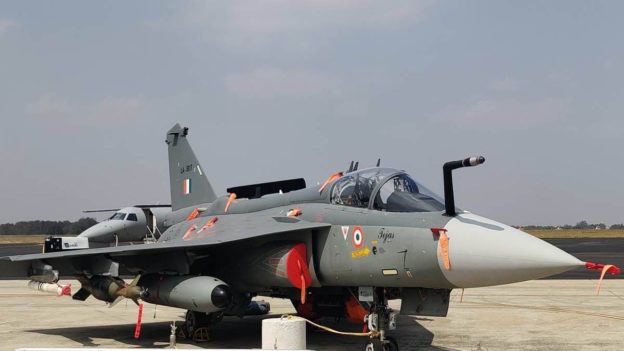As the largest defence importer, India has now shifted its strategy in the Aerospace & Defence Sector (A&D) towards ‘Make-in-India’ and further envisioned itself as a global manufacturing hub with ‘Make-in-India for the World’.
The Indian aerospace sector is abuzz with developments including the Tata-Airbus foundation stone being laid for building the C295 military transport aircraft. Garuda Aerospace has inked a deal with Lockheed Martin to integrate the latter’s advanced software with the former’s range of drones for commercial and defence purposes.
As the largest defence importer, India has now shifted its strategy in the Aerospace & Defence Sector (A&D) towards ‘Make-in-India’ and further envisioned itself as a global manufacturing hub with ‘Make-in-India for the World’. This policy has led to an indigenous aircraft carrier with over 75 percent indigenous content and a light combat aircraft with over 60 percent indigenisation.
Atmanirbharta, AMCA and a missing engine
The indigenisation push is built on a successful strategy of technology transfers and cooperative manufacturing wherein foreign Original Equipment Manufacturer (OEMs) partner with Indian counterparts – public and private, to manufacture in India for Indian defence needs. This caters to existing markets and fosters robust research and development in the country. A stellar example is the Indo-Russian BrahMos supersonic cruise missile.
In this bid for indigenisation, a key component missing from the puzzle has been the engine. Engine manufacturing for modern aircraft has been a secret guarded closer than nuclear technology.
A select few companies enjoy a global presence, with virtually no one else able to manufacture an engine indigenously. Hindustan Aeronautics Limited (HAL) has been unable to produce even a single, low-thrust engine indigenously. Therefore, it sought foreign OEMs to provide an engine for the Light Combat Aircraft (LCA) Tejas.
However, “foreign OEMs are replete with international political considerations. Hence, when HAL wanted a GE F414 engine that produced around 100 KN of thrust, it was stuck with a GE F404 engine with only 80 KN of thrust. For the LCA Tejas Mark II, the GE F414 engine will likely be incorporated. However, that will again underpower the Mark II variant, which could have carried more payloads and flown further,” Girish Linganna, Aerospace and Defence Analyst, explains to Financial Express Online.
In the midst of this, the Indian 5th generation aircraft programme, Advanced Medium Combat Aircraft (AMCA), is underway. For the AMCA, UK based Rolls Royce is expected to tie up with the Defence Research and Development Organisation (DRDO) to co-develop engines for this aircraft.
Also Read: Rolls Royce in talks with DRDO to rev up AMCA engines
“Jet engines contain more than 30,000 moving parts and require the input of various other industries like metallurgy, forging, casting and machining. This complexity poses a bottleneck to anyone aiming to develop an engine single-handedly,” opines Linganna.

Engines Made in India
With a push for defence exports and a sufficient domestic interest for state-of-the-art defence equipment, India is now in talks with various engine manufacturers to co-develop an engine for AMCA.
The French major, Safran, has already done a similar co-production with HAL for the Shakti helicopter engine. The Shakti engine powers the latest attack helicopter, Light Combat Helicopter (LCH) Prachand.
Also Read: IAF to add more teeth to its bite! Light Combat Helicopters to be inducted next month
A similar offer has been put forth by the British engine manufacturer Rolls Royce and the American manufacturer Pratt and Whitney. Even Indian players like Tata plan to work with GE in a joint venture to pitch an engine to HAL. Tata is already developing various engine components for various Leading Edge Aviation Propulsion (LEAP) engines.
According to Linganna “AMCA’s engine dilemma has inadvertently converted India into a battleground for engine manufacturers. With a co-development model, manufacturers will earn a piece of the pie out of AMCA and any further developments. HAL also looks to develop the engine for Hindustan Turbo Trainer 40 (HTT 40) indigenously. Annually, HAL plans to develop 170 aircraft, including exports.”
Also Read: India made HTT-40 to be unveiled at DefExpo 2022, deal for IAF expected soon
Flyer Friendly Future: The Global Aerospace Forecast
It is estimated that India’s domestic aviation market will contribute over US$ 30 billion annually to the Gross Domestic Product (GDP). Already the third largest in domestic traffic, it will also be the third largest domestic market. The government is pushing for more aerial connectivity and is expected to build 100 additional airports by 2024 under the UDAN scheme. This means, based on the information available in public domain the number of passengers will go up to over 500 million, with the fleet to be 2500 aircraft strong by 2040s.
Maintenance, Repair and Overhaul (MRO)
As the domestic industry booms, major manufacturers realise India’s geographical and technological potential. Hence, most manufacturers have announced maintenance, repair and overhaul (MRO) facilities for their aircraft to be localised, intending to make India the regional hub.
US based Boeing Company launched the Boeing India Repair Development and Sustainment (BIRDS) programme in 2021 with a vision to make India a regional MRO hub. It has partnered with Indian MSMEs like Air Works and Air India Engineering Services Limited (AIESL) to provide MRO for various Boeing aircraft in service with the Navy and the Air Force.
A major push for the MROs has been the policy rolled out last year by the Ministry of Civil Aviation. The policy included leasing land via open tenders, slashing the royalty charged by the Airports Authority of India (AAI) for MRO and also increasing the period of allotment to 30 years from 3-5 years. The policy aimed at making India a global ‘MRO hub’. The increased ease was aimed at curbing the practice of domestic aircraft flying to the Middle East for cheaper MRO.
https://www.financialexpress.com/defence/india-races-towards-becoming-a-global-aerospace-hub-on-strong-indigenisation-push/2771397/?utm_source=edu_landing_page&utm_medium=article_listing_widget&utm_campaign=Tags





